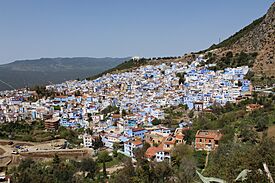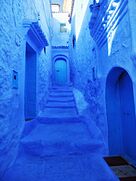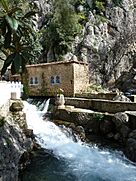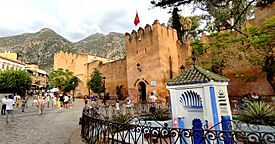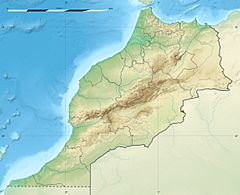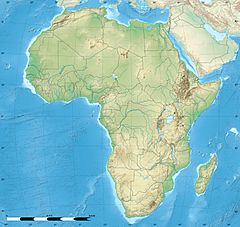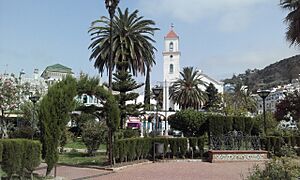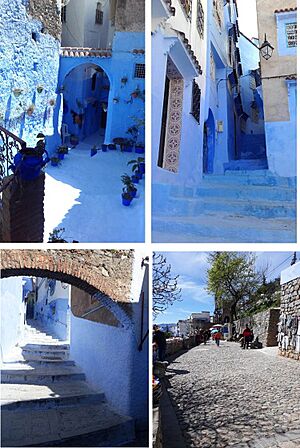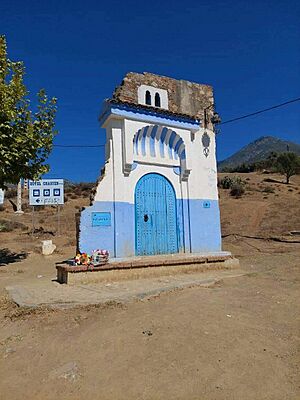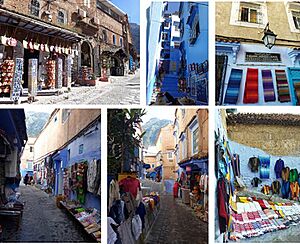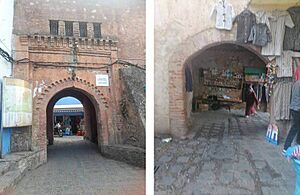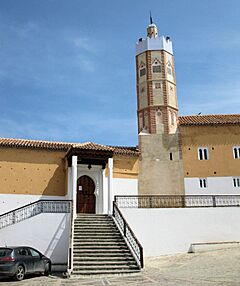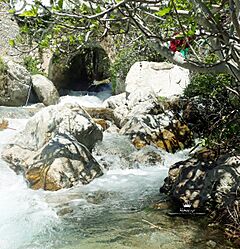Chefchaouen facts for kids
Quick facts for kids
Chefchaouen
شفشاون
|
||
|---|---|---|
|
Clockwise from top: Overall view of the city; Ras al Ma' stream; Uta Hammam Square and the Kasbah; one of the blue-painted streets in the medina
|
||
|
||
| Nicknames:
The Blue Pearl
(الجوهرة الزرقاء) |
||
| Country | Morocco | |
| Province | Chefchaouen | |
| Region | Tangier-Tetouan-Al Hoceima | |
| Founded | 1471 | |
| Elevation | 564 m (1,850 ft) | |
| Population
(2014)
|
||
| • Total | 42,786 | |
| Time zone | UTC+1 (CET) | |
Chefchaouen (which sounds like Shaf-shaa-wan) is a beautiful city in northwest Morocco. It's famous for its buildings that are painted in many shades of blue! This is why it's often called the "Blue City" or "The Blue Pearl." You can find it nestled in the Rif mountains, between the cities of Tétouan and Ouazzane.
The city was started in 1471 by a leader named Ali ibn Rashid al-Alami. He was a distant relative of the Islamic Prophet Muhammad. At first, it was just a small fortress, now known as Chefchaouen’s Kasbah. This fortress was built to protect the area from attacks by Portuguese invaders. At that time, Portugal was trying to take over cities and towns in northern Morocco.
Contents
What's in a Name?
The name "Chefchaouen" comes from Arabic words. "Chef" means "to look," and "Chaouen" means "antlers" or "horns." This name describes the two mountain peaks that look like horns watching over the city. So, Chefchaouen means 'look at the horns'. Today, it's known as "the Blue Pearl" because of its traditional houses painted in blue and white.
A Glimpse into History
Chefchaouen was founded in 1471. Ali ibn Rashid al-Alami built a small fortress, called a Kasbah, to protect the area from Portuguese attacks. Many people from al-Andalus (the Muslim-controlled parts of Spain) and Spanish and Portuguese Jews moved here. They came during and after the Reconquista, when Spanish Christians took back control of the Iberian Peninsula.
Ali Ben Rashid was a skilled warrior. He settled in Chefchaouen around 1465 and became a leader. He fought alongside the leader of Tétouan, Ali al-Mandri. Ali al-Mandri's daughter, Sayyida al-Hurra, later became a powerful ruler of Chefchaouen. She helped the city grow quickly.
After the fall of Granada in 1492, many more people moved to Morocco from Spain. Some of these refugees settled in Chefchaouen. They built their homes in the mountains, using a style similar to the buildings in Granada. In a short time, Chefchaouen grew from a fortress into a busy city. The culture of al-Andalus mixed with the local culture. New walls with gates were built, and several mosques, including the Great Mosque, were constructed.
In 1920, Spanish forces took control of the city. Later, from 1924 to 1926, Chefchaouen was part of the Republic of the Rif, led by Abd el-Krim. During the Rif War, American pilots even bombed the city. After Abd el-Krim was defeated, Spain took back control in 1926. Morocco became independent from colonial rule in 1956, and Chefchaouen became part of independent Morocco.
Where is Chefchaouen?
Chefchaouen is located about 600 meters (nearly 2,000 feet) above sea level. It sits at the foot of the Kaʻala mountain, which is part of the Rif mountain range in northwestern Morocco. The city has two main parts: the Medina, which is the old, walled town, and a newer part that has grown outside the old city walls.
People of Chefchaouen
In 2014, the city of Chefchaouen had a population of 42,786 people.
Culture and Traditions
Chefchaouen is in an area where the Jebala traditionally lived. Later, Muslim and Jewish refugees from Spain joined them. The city has always had strong connections with the surrounding tribes, especially for trade.
The traditional houses in Chefchaouen are made from stone, brick, and wood. Each house has an open courtyard in the middle, often decorated with fruit trees like oranges and lemons. You might also see sweet-smelling plants like jasmine. The city's look is influenced by Spanish architecture, with curved brick arches and narrow blue alleys. Many families in Chefchaouen still enjoy Andalusian music. This music is a big part of their religious festivals and social events.
Special Days and Celebrations
The people of Chefchaouen enjoy celebrating religious and social events. Here are a few:
- Sha’banah: This day happens on the 15th of Shaʽban (the 8th month of the Islamic calendar). People visit the tomb of Moulay Abd Salam Ben Mshish.
- The Night of Al-Qad: Celebrated on the 26th of Ramadan. Families encourage girls aged 7–10 to fast. They often celebrate at home and sometimes parade with the girls wearing special clothes.
- Ashura: This is on the 10th of Muharram. Families eat dried meat with couscous and dried fruits like almonds and raisins. Children often receive toys and gifts.
- Mawlid Nabawi: This celebrates Muhammad's birthday on the 12th of Rabii’ Al-Awwal. People read from the Quran and Muhammad's life story in mosques or at home. Food is often given to those in need.
- Hakouzah Day: Celebrated on January 1st of the agricultural calendar. People prepare and eat traditional foods to thank for the past harvest and hope for a good new year.
These celebrations are similar to those found in many other parts of Morocco.
Economy and Tourism
In 2020, Chefchaouen joined the UNESCO Global Network of Learning Cities. This network helps cities share ideas and work together to improve.
Farming and Industry
Farming is very important in the Chefchaouen area. People grow olives, grapevines, almonds, and figs. The industrial sector is small, but the city has many natural resources.
Trade and Tourism
Trade is a key part of Chefchaouen's economy, especially because of tourism and money sent home by people working abroad. Shops sell traditional foods, building materials, clothes, and household items. Business is busiest in the summer when tourists visit and people return home from other countries.
Chefchaouen is a popular place for both Moroccan and international tourists. They come to see its beautiful natural scenery and historical sites. Tourism is mostly seasonal, with many European visitors in the summer. In 2018, about 120,000 tourists visited the city. The blue Medina is a huge draw, and the region's natural beauty is also promoted. A nearby attraction is the Kef Toghobeit Cave, one of Africa's deepest caves.
Handicrafts
Handicrafts are a very common and important economic activity in Chefchaouen. This includes things like sewing, blacksmithing, carpentry, and leatherwork. This sector is closely linked to tourism. Many artisans work with leather, textiles, iron, and wood. Wood products are the most popular handmade items sold in Chefchaouen.
Famous Landmarks
Chefchaouen's blue walls are very famous. There are different ideas about why they are blue. Some say the blue color helps keep mosquitos away. Others believe the blue symbolizes the sky and heaven, reminding people to live a spiritual life. However, some locals say the walls were painted blue in the 1970s mainly to attract tourists.
The Medina: Old Town Charm
The Medina is the historic heart of Chefchaouen. Here, blue and white paint covers almost all the walls and houses. The Medina was once surrounded by defensive walls, and some of its old gates are still standing.
The main square in the Medina is Uta Hammam Square (also called Place Outa Hammam). This market square is surrounded by important buildings like the Kasbah, the Great Mosque, and a caravanserai (an old inn for travelers). You'll also find many shops and cafes here. The square was likely created in the 16th century.
The funduq (caravanserai) is the largest of four in the city. It was built to house merchants and travelers. It has a courtyard surrounded by rooms on different levels.
The Souika neighborhood, one of the oldest parts of the city, is located southwest of the Kasbah. Its name means "Little Souk" (market), because it used to have a market.
Many traditional fountains are found throughout the old city. They used to provide water for everyone. One example is the four-sided fountain in the center of Uta Hammam Square. Another is the Aïn Souika Fountain in the Souika neighborhood.
The Kasbah: A Historic Fortress

The oldest part of the Medina is the Kasbah. This fortress was built in the late 15th century by Ali ibn Rashid. It has strong walls made of packed earth and ten towers. There's also a taller tower on the west side, built in the early 16th century. This tower has several rooms inside.
Today, the Kasbah is a museum with a lovely garden in its courtyard. The museum shows off old objects and tells the story of the area's culture.
Important Religious Sites
The Grand Mosque of Chefchaouen is the city's oldest and most important mosque. It's located in Place Outae Hammam, right in the heart of the Medina. The Spanish Mosque is another mosque, now unused, that sits on a hill overlooking the town. It was built by the Spanish in the 1920s and is a popular spot for great views.
Outside the city, you can find the Mausoleum of Abdessalam Ben Mshish al-Alami. This is a special place dedicated to the patron saint of the northern Morocco's Jebalah region.
Ras al-Ma': The Water Source
This natural water source is just east of the Medina. It was the original place where the city got its water. The spot where the water comes out is now enclosed by a stone structure. Nearby, there's an old mill and a bridge that crosses the stream.
Sister Cities
Chefchaouen has "sister city" relationships with other cities around the world. This means they share culture and ideas. Some of its sister cities include:
 Issaquah, Washington, United States
Issaquah, Washington, United States Vejer de la Frontera, Spain
Vejer de la Frontera, Spain Ronda, Spain
Ronda, Spain Kunming, China
Kunming, China Testour, Tunisia
Testour, Tunisia Mértola, Portugal
Mértola, Portugal Beni Mellal, Morocco (a city within Morocco)
Beni Mellal, Morocco (a city within Morocco)
Famous People from Chefchaouen
- Ahmed Hammoudan, a professional football player
- Abdelkarim Tabbal, a poet
- Sayyida al Hurra, a powerful queen and governor
Images for kids
See also
 In Spanish: Chauen para niños
In Spanish: Chauen para niños


